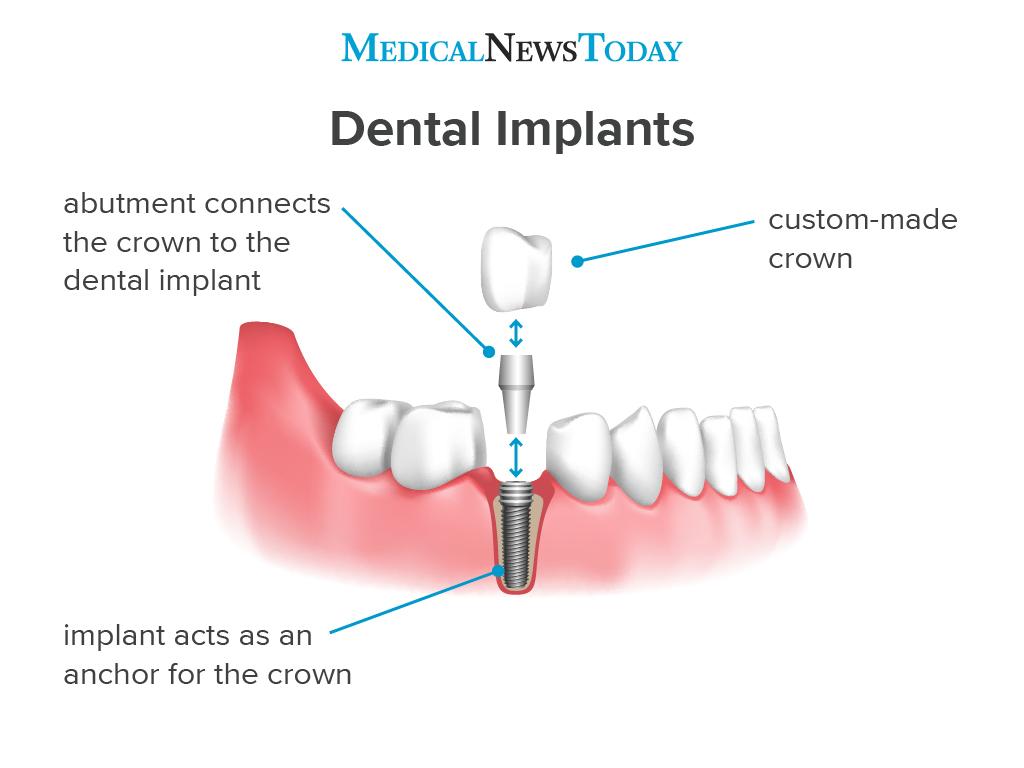Dental Implants Fundamentals Explained
Dental Implants Fundamentals Explained
Blog Article
Dental Implants Things To Know Before You Get This
Table of ContentsSome Of Dental ImplantsNot known Factual Statements About Dental Implants Unknown Facts About Dental ImplantsSome Of Dental Implants
are medical devices surgically implanted right into the jaw to restore an individual's capacity to chew or their appearance. They supply support for artificial (phony) teeth, such as crowns, bridges, or dentures. When a tooth is lost due to injury or illness, a person can experience difficulties such as fast bone loss, faulty speech, or adjustments to chewing patterns that result in pain.
Framework of The Dental Implant System choosing dental implants, talk with your dental provider concerning the prospective advantages and threats, and whether you are a candidate for the procedure. Points to think about: Your general wellness is an essential consider determining whether you are a good prospect for oral implants, the length of time it will take to recover, and how much time the implant may remain in area.
Smoking might impact the recovery procedure and lower the long-term success of the implant. The healing process for the implant body might take numerous months or longer, during which time you typically have a short-lived abutment in location of the tooth. the oral implant procedure: Thoroughly comply with the dental hygiene directions offered to you by your oral service provider.
What Does Dental Implants Mean?
Implant failing can lead to the requirement for another procedure to fix or change the implant system. Restores the capability to chew Brings back aesthetic look Aids keep the jawbone from reducing because of bone loss Maintains the health of the surrounding bone and gums Assists maintain surrounding (nearby) teeth steady Boosts quality of life Damages to bordering all-natural teeth during implant positioning Injury to the surrounding tissues during surgical procedure, such as sinus opening Injury throughout surgical procedure (for example, fracture of surrounding jawbone) Insufficient function, such as seeming like the teeth do not bite together normally A feeling that the tooth hangs or turning in position arising from a joint screw loosening up Implant body failing (looseness of the dental implant body) because of systemic infection, which might be more probable in individuals with unrestrained diabetics issues because of regional infection in bone and gum tissues supporting the implant body visit the site as a result of delayed recovery, which may be more probable in patients who smoke Difficulty cleansing the gums around the dental implant, leading to inadequate dental health Untreated gum condition Post-surgical tingling as a result of nerve impingement or damage Always notify healthcare suppliers and imaging professionals that you have dental implants before any kind of magnetic resonance imaging (MRI) or x-ray procedures.
FDA is not aware of any type of negative events reported for MRI or x-ray treatments with oral implants. Dental implants systems are usually constructed from materials that follow international agreement criteria of the International Organization for Standardization (ISO) or ASTM International. These standards have details of what makes a safe material.
Various other materials such as gold alloys, cobalt-based alloys, titanium alloys, or ceramic products are sometimes utilized. The security accounts of these materials are well-known. Dental implant systems are reviewed according to worldwide consensus standards. Biocompatibility screening, to reveal that physical call with the gadget does not cause difficulties like irritability or sensitive reaction, is component of the assessment that helps guarantee the products in the dental implant system are safe visit here and do not cause adverse effects when dental implanted in people.

The smart Trick of Dental Implants That Nobody is Discussing
Some people are not qualified for dental implant surgical treatment. It is for dental doctors to operate individuals with: severe illnessuncontrollable metabolic diseasebone or soft cells disease or infectionIf these issues are fixed, an individual can have the surgical treatment. Dental Implants. In, oral cosmetic surgeons avoid running on individuals with: If people with any one of the above undergo oral implant surgical treatment, there is a higher threat of the dental implant stopping working
Some individuals have a jawbone irregularity that protects against adequate bone for an implant from establishing. In such cases, a specialist might require to carry out a ridge adjustment. This involves lifting the periodontal to reveal the location of flawed bone. The doctor will certainly then use a bone or bone replacement to go to these guys repair and develop the location.
Oral dental implant surgical procedure is a customized procedure. Offer you time to heal. Attach the post and last crown, bridge or denture.
Next off, your doctor will thoroughly place the dental implant right into your jaw. If your implant is near the front of your mouth, your dentist will certainly make a momentary tooth for you to use till you recover.
How Dental Implants can Save You Time, Stress, and Money.
Your copyright can tell you what to expect in your scenario. During the healing phase, your jawbone ought to fuse to the oral implant. This procedure, called osseointegration, is critical for security and long-lasting success. This process can take anywhere from 3 to 9 months. In some instances, it may take longer.
When your implant heals, your dental expert can affix the abutment (little port message) and your last reconstruction (crown, bridge or denture). This usually takes regarding one hour to finish and may require a second minor surgical treatment. You shouldn't really feel any kind of pain during your dental implant procedure because your company will certainly make use of medicine to numb your periodontals.
Report this page